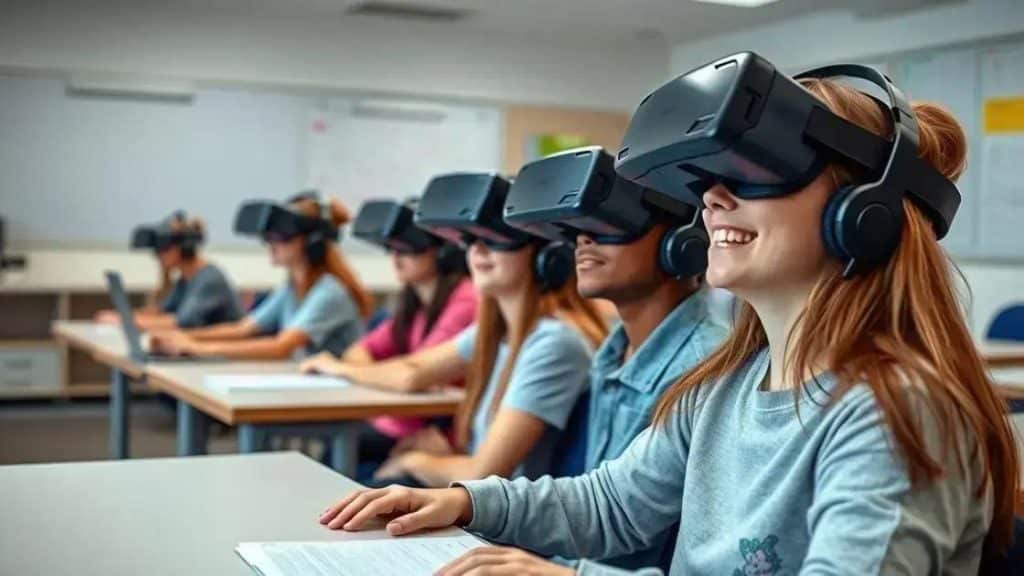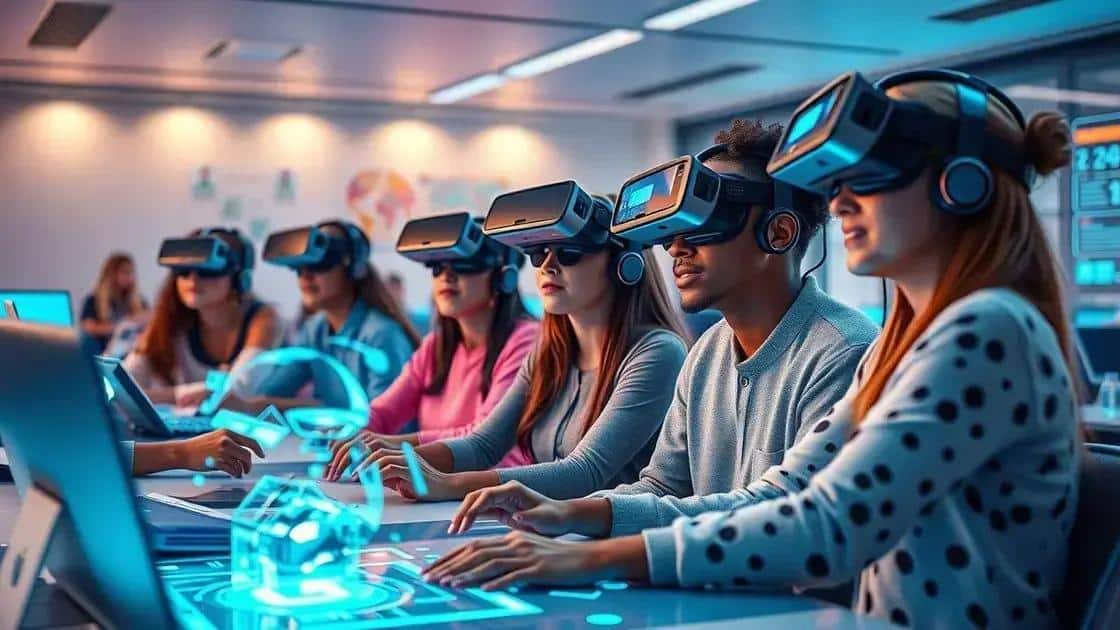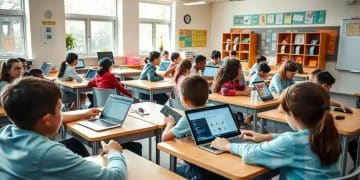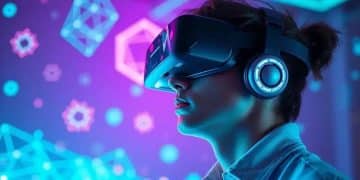VR learning environments – emerging trend in education

VR learning environments enhance education by providing immersive, interactive experiences that increase student engagement and understanding while addressing various learning needs.
VR learning environments are becoming an exciting part of modern education, offering immersive experiences that traditional classrooms can’t. Have you ever imagined learning in a virtual world? Let’s dive into how this trend is reshaping education.
Understanding VR learning environments
Understanding VR learning environments is essential as they bring a new dimension to education. These immersive spaces allow students to engage in learning through interactive experiences that traditional settings cannot provide. Imagine students walking through ancient cities or exploring the human body, all from their classroom!
What are VR learning environments?
Essentially, VR learning environments use virtual reality technology to create simulated experiences. Through the use of headsets and interactive elements, students can visualize and interact with subjects in a dynamic way.
Benefits of VR in education
Integrating VR technology in the classroom can boost student engagement and retention of information. Here are some key benefits:
- Enhanced student engagement through interactive lessons.
- Realistic simulations provide practical learning experiences.
- Personalized learning, catering to different learning styles.
This innovative approach makes learning more exciting! Students are not just passive recipients of information; they become active participants in their education. As they navigate through these virtual experiences, their understanding deepens, and they can apply what they learn in real-world contexts.
Challenges to implementation
While there are many advantages to VR learning environments, there are also challenges. Schools must consider the costs of technology and training. Additionally, not all subjects may benefit equally from VR. Thus, careful planning is essential to maximize its effectiveness. By addressing these obstacles, educators can harness the full potential of VR technology.
With the right tools and strategies, VR learning environments can transform how education is delivered, making learning more impactful and enjoyable for students. Overall, the potential of this technology continues to grow, promising a bright future for education.
Benefits of using VR in education

The benefits of using VR in education are numerous and transformative. Students are experiencing education in a whole new way, which can enhance their learning journey significantly. Imagine science classes where students can explore the human body up close or history lessons that transport them to ancient civilizations!
Enhanced Engagement
One of the primary advantages of VR is increased student engagement. When learners can interact with content in a virtual environment, they are often more motivated to participate. This excitement can lead to better retention of knowledge.
Real-World Applications
VR in education allows students to apply what they learn in real-world situations. For instance, a virtual lab can provide hands-on experience without the risks associated with actual experiments. This type of learning fosters critical thinking and problem-solving skills.
- Students can experience situations they wouldn’t encounter in traditional classrooms.
- They have the chance to practice skills safely and effectively.
- Learning can be tailored to individual needs and learning styles.
Another huge benefit is the ability for students to explore complex concepts in a simplified manner. Think about mathematics or engineering; abstract ideas can become concrete when visualized in a virtual space. This can lead to a deeper understanding of subjects that many find challenging.
Accessibility and Inclusivity
VR learning environments can also promote inclusivity in education. Students with disabilities can engage in experiences that may be difficult in physical settings. For example, a student with mobility issues can participate in a virtual field trip that might otherwise be inaccessible.
Moreover, VR can bridge gaps for students who learn differently. By providing multi-sensory experiences, it caters to visual, auditory, and kinesthetic learners simultaneously.
Challenges in implementing VR learning
Challenges in implementing VR learning can be significant, and understanding them is crucial for successful integration in education. While the benefits are apparent, there are obstacles that educators must navigate. One major challenge is the high cost of VR technologies. Schools may struggle to afford the necessary headsets, software, and infrastructure.
Technology Accessibility
Access to technology is another barrier. Not every student has equal access to VR resources, resulting in potential inequalities in learning experiences. Additionally, if schools do not have the latest technology, it may be difficult to provide an effective VR learning environment. This limited access can widen the gap between students who can afford these tools and those who cannot.
Training and Support
Another significant hurdle is the need for adequate training for teachers. Integrating VR effectively requires educators to be comfortable with the technology. They need to understand how to design lessons that leverage virtual reality effectively. Without proper training and ongoing support, teachers may hesitate to fully embrace this innovative teaching method.
- Establishing a tech support system is crucial for troubleshooting.
- Ongoing professional development can boost teacher confidence.
- Collaboration among educators can foster innovation and share best practices.
Moreover, there are questions about the adequacy of VR content. Not all subjects may have sufficient resources available in VR formats. Teachers might face difficulties finding appropriate materials that align with their curriculum. This can lead to frustration and lower the effectiveness of VR as a teaching tool.
Lastly, issues regarding students’ health and safety have emerged. Prolonged use of VR can cause discomfort or motion sickness for some learners. Establishing guidelines for safe usage is essential to ensure a positive learning experience. By addressing these challenges thoughtfully, educators can pave the way for the effective use of VR learning environments.
The future of VR learning environments

The future of VR learning environments looks promising as technology continues to evolve. New advancements are making virtual reality more accessible and effective for education. Students can look forward to learning experiences that are not only engaging but also innovative.
Technological Advancements
As technology improves, VR in education will become more integrated into everyday learning. Emerging technologies such as artificial intelligence can personalize learning experiences. This means students will encounter lessons tailored to their skills and interests, enhancing their motivation and success.
More Interactive Experiences
In the future, VR learning environments will offer even more interactivity. Imagine virtual classrooms where students collaborate on large-scale projects in real-time. They will be able to interact with complex data and simulations that bring their lessons to life.
- Group projects can take place in virtual settings that mimic real-world scenarios.
- Immersive storytelling can deepen understanding of subjects.
- Students might explore historical events or scientific phenomena firsthand.
Moreover, the global reach of VR technology will allow students from different parts of the world to connect and learn together, promoting cultural exchange and collaboration. Schools can provide virtual field trips to anywhere in the world without leaving the classroom.
Focus on Inclusivity
The future of VR learning environments also focuses on inclusivity. Educators are aiming to create experiences that cater to diverse learning needs. Virtual reality can help provide learning opportunities for students with disabilities, offering alternative methods of engagement that can help them excel.
As developers create more accessible materials, VR in education is set to become a crucial tool in leveling the playing field for all learners. This shift toward inclusivity will foster a learning environment where every student has the chance to thrive.
VR learning environments are changing the future of education in exciting ways. By making learning more engaging and accessible, VR is paving the way for a more interactive and inclusive classroom. Challenges remain, but as technology continues to advance, the potential for transformative educational experiences is limitless. Educators, students, and school systems can work together to make the most of this innovative approach, ensuring every learner has the opportunity to succeed.
FAQ – Frequently Asked Questions about VR Learning Environments
What are VR learning environments?
VR learning environments use virtual reality technology to create immersive experiences that enhance learning and engagement.
How can VR benefit students in education?
VR can make learning more interactive, improve retention, and allow students to apply concepts in real-world scenarios.
What challenges do educators face when implementing VR in classrooms?
Challenges include high costs, the need for proper training, and ensuring equitable access to technology for all students.
What does the future hold for VR in education?
The future of VR in education is bright, with technological advancements leading to more interactive, personalized, and inclusive learning experiences.





